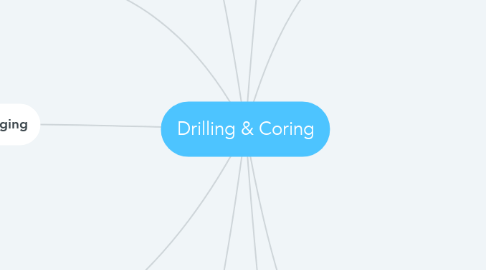
1. type of rotary coring analysis
1.1. Conventional coring
1.1.1. Large diameter core as much as >5 inches
1.1.2. Bring cores to the surface
1.1.3. proceed with normal drilling operations without removing the drilling tools from the hole
1.2. Wireline retrievable coring
1.2.1. Drilling operations cannot be resumed without removing the drill pipe from the hole
1.3. Diamond coring
1.3.1. Advantageous in coring hard,dense formations where the cost of the coring with roller cutter bits is high
1.3.2. Increase both core recovery and penetration rate
2. Mud logging
2.1. First evaluation methods during exploration
2.2. Plot wellsite activities and cuttings analysis versus depth
2.3. useful for
2.3.1. Identification of the lithology and formation type
2.3.2. Identification of porous/permeable zones
2.3.3. Confirmation of hydrocarbons
3. well logging
3.1. open holed
3.2. cased hole
3.3. logging while drilling (LWD)
3.3.1. drill string
3.3.2. bottom hole assembly (BHA)
4. type of log
4.1. Lithologic Logs
4.1.1. Spontaneous Potential
4.1.2. Gamma Ray
4.2. Porosity Logs
4.2.1. Density
4.2.2. Neutron
4.2.3. Sonic
4.3. Resistivity Logs
4.3.1. Resistivity
4.3.2. Induction
4.4. Dipmeter
4.5. Caliper
5. contour
5.1. isopach
5.2. isochore
6. type of rig
6.1. jacket
6.2. jack-up
6.3. fpso
6.4. spar
6.5. drilling ship
6.6. semi submersible
6.7. compliant tower
6.8. tension leg platform
7. type of drilling system
7.1. power
7.1.1. large diesel engine
7.1.2. electrical generator
7.2. hoisting
7.2.1. drawworks
7.2.2. turntable
7.3. rotary
7.3.1. swivel
7.3.2. kelly
7.3.3. rotary table or turntable
7.3.4. drilling string
7.3.5. drilling bit
7.4. circulating
7.4.1. pump
7.4.2. hose and pipes
7.4.3. mud-return line
7.4.4. mud pits
7.4.5. shale shaker
7.4.6. desander
7.4.7. desilter
7.4.8. shale slide
7.4.9. reserve pit
7.5. well control
7.5.1. drilling mud
7.5.1.1. Control formation pressures
7.5.1.2. Transport cuttings to the surface
7.5.1.3. Cooling and lubricating the bit
7.5.1.4. Transmitting hydraulic energy to the bit and downhole tools
7.5.1.5. Maintaining wellbore stability
8. Side-Wall Coring
8.1. Spontaneous Potential and Gamma Ray
8.2. cores can be taken from several levels and at different locations
8.3. cores samples are small rock obtained by shooting a hollow ‘bullet’
8.3.1. thirty bullets per gun (60 core/run, 2 gun).
8.4. supplementary coring method used in zones where core recovery by conventional methods
9. log correlation
9.1. Correlation tools:
9.1.1. Electric Logs :
9.1.1.1. SP (Spontaneous Potential)
9.1.1.2. Neutron Porosity
9.1.1.3. ‒ GR (Gamma Ray)
9.1.1.4. Resistivity Log (ILD or MSFL)
9.1.1.5. Sonic
9.1.1.6. Density Log
9.1.2. Others:
9.1.2.1. Seismic picks
9.1.2.2. Microfossils data
9.1.2.3. Core description data
9.2. types of correlation:
9.2.1. Stratigraphic Correlation
9.2.2. Structural Correlation

